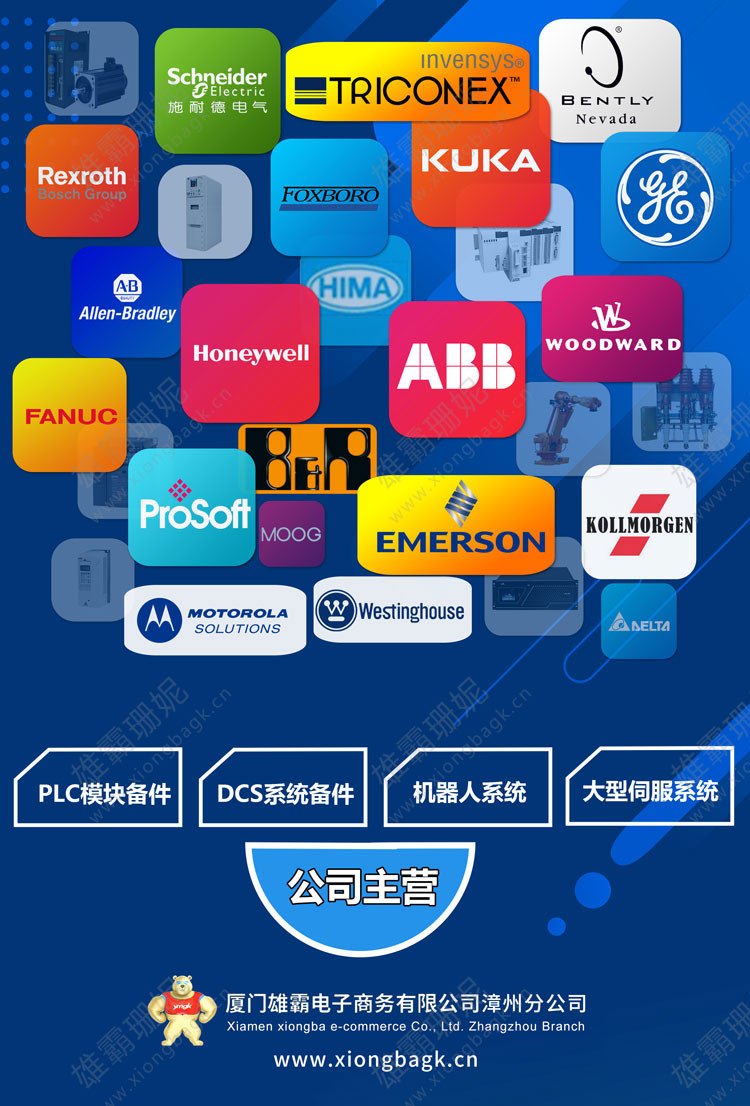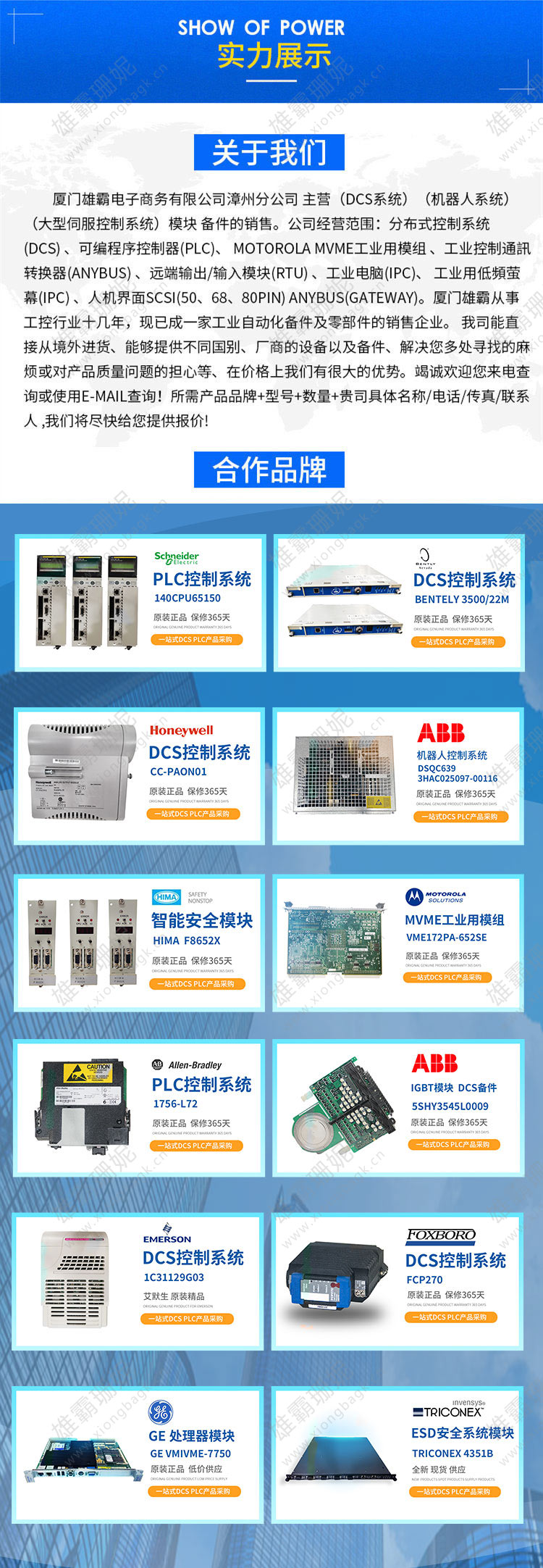产品详情
详情介绍:DS200TBQAG1ABA 接触器驱动板
零件号:DS200TBQAG1ABA
制造商:通用电气
系列:驾驶员控制
功能描述:接触器驱动板
供货情况:有现货
保险丝:4安125伏
测试点:3个
LED指示灯:1
维修:3-7天
产品类型:印刷电路板
手册:GEI-100182B
制造国:美国
功能描述
DS200CDBAG1A是GE公司开发的接触器驱动板。它是驾驶员控制系统的一部分。该组件向电源板或DC电源和仪表板供电,以打开和关闭接触器。接触器的线圈电压范围为30至40伏直流电。该模块通过施加105 V直流电250毫秒以强制接触器闭合来闭合接触器。为了保持接触器闭合,电路板将接触器驱动电流调节到使用电位计RV1设置的水平。该组件包括三个测试点、一个保险丝、接线连接器、可配置跳线、一个LED指示灯和一个电位计。这些功能为用户提供了很多控制,并支持特定于应用程序的定制。pot允许用户控制接触器驱动器的电流。跳线用于选择协调操作。用户可以使用测试点检查电压信号。该板通过三个插头连接器和一个端子板发送和接收输出信号。有关连接器位置的更多信息可在相关手册中找到。该板包括一个用于调节接触器驱动电流的电位计。这通常设置为1.5安培。
特征
- 更换电路板时,将新(更换)电路板上的电位计RV1设置在与被更换电路板相同的位置。不调整DS304型接触器上的电位计可能会导致接触器线圈故障。测试点都在CDBA公共区(ACOM)引用,这与驱动公共区不同。因此,所有测试测量必须使用能够测量浮动电位的隔离测试设备进行。
- 选择协调操作时,LED会显示本地触点闭合命令的状态。
- 输入电源由FU1融合,用于为电路板提供75至140 V交流/直流电源。接触器的线圈电压必须在30至40伏直流电之间。
- 它将驱动器控制连接到高速接触器,允许驱动器中的快速丢失保护。
- 有三个测试点。测试点允许检查REFA电压信号+15 V DC电源。该板上包括三个测试点、一个保险丝、接线连接器、可配置跳线、一个LED指示灯和一个电位计。
- 这些功能为用户提供了对产品的大量控制,并支持特定于应用程序的定制。pot允许用户控制接触器驱动器的电流。跳线用于选择协调操作。用户可以使用测试点检查电压信号。有关这些器件的更多信息,包括电路板保护保险丝的信息,可在相关手册中找到。无论如何,该板的多功能性使其成为一款非常理想的精心设计的PCB。
可配置硬件
- 在电路板的硬件配置中,它包括两个伯格型跳线TP1和J2,以及一个标为RV1的可调电位计。TP1和J2跳线有多种用途,例如帮助制造测试,并为客户提供根据其特定需求定制电路板的选项。此外,可调电位计RV1在系统中起着关键作用,主要用于调节接触器驱动电流。通常,RV1用于精确控制接触器驱动电流,使其保持在1.5 A的水平。
- 对于DS304型接触器,建议使用0.75 A的特定驱动电流,并可进行相应配置。这些可配置的硬件元件使用户能够调整电路板的设置以满足特定要求,从而确保最佳性能和功能。
车载保险丝
- 该组件在电路板的115 V交流输入电源上有一个保护保险丝FU1。FU1是一个4安、125伏、2安的慢熔断保险丝。如果FU1继续熔断,CDBA板很可能有故障,应该更换。
产品属性
- 电源:本文中的电源单元是系统的心脏,负责将电源的交流电压转换为稳定且可控的低压直流电压(DC)。这种转换对于确保各种电子元件和设备获得有效工作所需的适当电源至关重要。
- 继电器:继电器在系统电力的控制和分配中起着关键作用。它们充当开关,启用或禁用不同设备或组件的电源。通过控制电流,继电器允许对各种功能进行精确管理,并使连接的设备能够安全运行。
- 微控制器:负责管理和协调输入和输出信号,做出实时决策并执行编程指令。这种智能使电路板能够响应外部激励并根据预定义的逻辑操作器件。
- 输入接口:输入接口为驱动板提供了与外部环境通信的方式。这些接口可能包括数字输入引脚、模拟输入引脚以及通用异步收发器(UART)、内部集成电路(I2C)或串行外设接口(SPI)通信接口。它们允许电路板从各种来源接收数据、命令或传感器读数,从而促进与周围系统的交互。
- 输出接口:输出接口使驱动板能够与外部设备通信并控制外部设备。这些接口可以包括数字输出引脚、脉宽调制(PWM)输出引脚以及UART、I2C或SPI通信接口。它们使电路板能够向连接的设备发送信号、命令或数据,从而促进任务的自动化和协调。
- 保护电路:保护电路是驱动板设计中的重要安全措施,可确保驱动板及其控制的设备的安全性和寿命。这些电路监控过流、过压和短路情况,立即采取措施防止损坏或故障。保护电路在保持系统可靠性和防止灾难性故障方面发挥着至关重要的作用。
- LED指示灯:LED指示灯为监控驱动板和连接设备的状态和性能提供了一种直观的方式。它们提供实时反馈,指示电源状态、操作模式或错误情况。LED指示灯增强了用户友好性并简化了故障排除过程。
- 扩展能力:许多驱动板都设计有扩展能力,具有插槽或连接器,可连接额外的外围设备或传感器。这些扩展选项允许系统定制和可扩展性,根据需要适应新功能的集成或专用设备的连接。
- 编程接口:编程接口是更新和定制驱动板固件或软件的重要组件。它提供了一种向微控制器上传新代码的方式,支持系统升级、功能增强或错误修复。该接口使用户能够根据不断变化的要求调整电路板,并优化其性能。
应用数据
- 板硬件:由接线连接器(端子板和插头连接器)、一个电位计、两个可编程跳线、一个LED指示灯、三个测试点和一个保险丝组成。本节接下来的段落提供了这些产品的描述。
- 电位计:包括一个用于设置接触器驱动电流的可调电位计。
- 可配置跳线:每一代G1A上都有一个用于工厂测试选择的可编程跳线。从G1BBA版本开始的板有两个可编程跳线,用于同步操作选择和工厂测试选择。
硬件配置
硬件配置是指通过跳线或开关等物理组件调整硬件设备设置的过程。受支持的ARCNET控制器板通常包含这些元素,以便于硬件配置。
这些板保持配置各种参数的能力,例如:
- 双端口内存基址:这个设置决定了双端口内存在内存中的映射位置,它允许不同的设备同时访问。
- I/O基址:指定输入/输出范围内的基址,控制板在此范围内与其他设备或CPU通信。
- PC的ARCNET地址:该地址在ARCNET网络中唯一地标识PC,允许它向网络上的其他设备发送数据和从网络上的其他设备接收数据。
- 中断请求级别(IRQ):定义控制器用来通知CPU注意或采取行动的中断线路。这对于管理硬件中断和确保设备之间的正常通信至关重要。
DS200TBQAG1ABA
Part Number: DS200CDBAG1A
Manufacturer: General Electric
Series: Driver Control
Functional Description: Contactor Driver Board
Availability: In Stock
Fuse: 4 amp 125V
Test points: 3
LED indicator: 1
Repair: 3-7 Days
Product Type: PCB
Manual: GEI-100182B
Country of Manufacture: United States (USA)
Functional Description
DS200CDBAG1A is a Contactor Driver Board developed by GE. It is a part of Driver Control control system. The component provides power to the Power Supply Board or DC Power Supply and Instrumentation Board to open and close a contactor . The coil voltages of the contactors range from 30 to 40 V dc. The module closes a contactor by applying 105 V dc for 250 msec to force the contactor closed. To keep the contactor closed, the board regulates the contactor drive current at the level set using pot RV1. Three test points, a fuse, wiring connectors, configurable jumpers, an LED indicator, and a potentiometer are included on this component. These features give the user a lot of control and enable application-specific customization. The pot allows users to control the current of the contactor driver. Jumpers are used to select coordinated operations. Users can check voltage signals using test points. This board transmits and receives output signals via three plug connectors and a terminal board. More information about connector location can be found in associated manuals. This board includes a potentiometer for adjusting the contactor driver current. This is typically set to 1.5 amps.
Features
- When replacing the board, set pot RV1 on the new (replacement) board to the same position as on the replaced board. Failure to adjust the pot on DS304-type contactors may cause the contactor coil to fail. Testpoints are all referenced at CDBA common (ACOM), which is not the same as drive common. As a result, all test measurements must be carried out using isolated test equipment capable of measuring floating potentials.
- When the coordinated operation is chosen, an LED displays the status of the local contact close command.
- The input power is fused by FU1 and used to power the board from 75 to 140 V ac/dc. The coil voltages of the contactors must be between 30 and 40 V dc.
- It connects the drive control to a high-speed contactor, allowing for quick dropout protection in the drives.
- There are three testpoints. The testpoints allow the REFA voltage signal +15 V DC power supply to be checked. Three test points, a fuse, wiring connectors, configurable jumpers, an LED indicator, and a potentiometer are included on this Board.
- These features give the user a lot of control over the product and enable application-specific customization. The pot allows users to control the current of the contactor driver. Jumpers are used to select coordinated operations. Users can check voltage signals using test points. More information on these devices, including information on the board’s protective fuse, can be found in the associated manuals. Regardless, the versatility of this board makes it a highly desirable and well-designed PCB.
Configurable Hardware
- Within the board’s hardware configuration, it include two Berg-type jumpers, TP1 and J2, as well as an adjustable potentiometer labeled RV1. The jumpers, TP1 and J2, serve multiple purposes, such as aiding in manufacturing testing and providing options for customers to tailor the board to their specific needs. Additionally, RV1, the adjustable potentiometer, plays a pivotal role in the system, primarily used to regulate the contactor drive current. Typically, RV1 is employed to finely control the contactor drive current, maintaining it at a level of 1.5 A.
- For DS304-type contactors, a specific drive current of 0.75 A is recommended and can be configured accordingly. These configurable hardware elements empower users to adapt the board’s settings to meet particular requirements, ensuring optimal performance and functionality.
On board fuse
- The component has a protective fuse FU1 on the board’s 115 V ac input power. FU1 is a slow-blowing 4 A, 125 V, 2AG fuse. If FU1 continues to blow, the CDBA board is most likely faulty and should be replaced.
Product Attributes
- Power Supply: The power supply unit in this context serves as the heart of the system, responsible for converting alternating current (AC) voltage from a power source into a stable and controlled low-voltage direct current (DC) output. This conversion is crucial for ensuring that various electronic components and devices receive the appropriate power they need to operate effectively.
- Relays: Relays play a pivotal role in the control and distribution of electrical power within the system. They act as switches that enable or disable the power supply to different devices or components. By controlling the electrical flow, relays allow for precise management of various functions and enable the safe operation of connected devices.
- Microcontroller: Responsible for managing and coordinating input and output signals, making real-time decisions, and executing programmed instructions. This intelligence enables the board to respond to external stimuli and operate devices according to predefined logic.
- Input Interfaces: Input interfaces provide the means for the driver board to communicate with the external environment. These interfaces may include digital input pins, analog input pins, as well as universal asynchronous receiver-transmitter (UART), inter-integrated circuit (I2C), or serial peripheral interface (SPI) communication interfaces. They allow the board to receive data, commands, or sensor readings from various sources, facilitating interaction with the surrounding systems.
- Output Interfaces: Output interfaces enable the driver board to communicate with and control external devices. These interfaces can encompass digital output pins, pulse-width modulation (PWM) output pins, and UART, I2C, or SPI communication interfaces. They enable the board to send signals, commands, or data to connected devices, facilitating the automation and coordination of tasks.
- Protection Circuits: Protection circuits are vital safeguards incorporated into the driver board’s design to ensure the safety and longevity of the board and the devices it controls. These circuits monitor for over-current, over-voltage, and short-circuit conditions, immediately taking action to prevent damage or malfunction. Protection circuits play a critical role in maintaining system reliability and preventing catastrophic failures.
- LED Indicators: LED indicators offer a visual means of monitoring the status and performance of the driver board and the connected devices. They provide real-time feedback, indicating power status, operational modes, or error conditions. LED indicators enhance user-friendliness and simplify troubleshooting processes.
- Expansion Capabilities: Many driver boards are designed with expansion capabilities, featuring slots or connectors to attach additional peripheral devices or sensors. These expansion options allow for system customization and scalability, accommodating the integration of new functionalities or the connection of specialized equipment as needed.
- Programming Interface: The programming interface is a crucial component for updating and customizing the driver board’s firmware or software. It provides a means to upload new code to the microcontroller, enabling system upgrades, feature enhancements, or bug fixes. This interface empowers users to adapt the board to changing requirements and optimize its performance.
Application Data
- Board Hardware: Made up of wiring connectors (terminal boards and plug connectors), a potentiometer, two programmable jumpers, an LED indication, three test points, and a fuse. The paragraphs that follow in this section provide descriptions of these products.
- Potentiometer: Include an adjustable pot for setting the contactor driver current.
- Configurable Jumpers: One programmable jumper for factory test selection is present on every G1A generation. The boards from revision G1BBA forward have two programmable jumpers for synchronized operation selection and factory test selection.
Hardware Configuration
Hardware configuration refers to the process of adjusting settings on hardware devices through physical components like jumpers or switches. Supported ARCNET controller boards typically incorporate these elements to facilitate hardware configuration.
These boards maintain the capability to configure various parameters such as:
- Dual-Ported Memory Base Address: This setting determines the location in memory where the dual-ported memory, which allows simultaneous access by different devices, is mapped.
- I/O Base Address: Specifies the base address in the input/output range where the controller board communicates with other devices or the CPU.
- ARCNET Address of the PC: This address uniquely identifies the PC within the ARCNET network, allowing it to send and receive data to and from other devices on the network.
- Interrupt Request Level (IRQ): Defines the interrupt line used by the controller to signal the CPU for attention or action. It’s crucial for managing hardware interrupts and ensuring proper communication between devices.
其他相近型号:DS200TBQAG1ABA 接触器驱动板
3500/42M 176449-02弯曲内华达轴振动模块516tx 336A4940DNP516TX GE A微处理器器件
316tx – 336a4940dnp516tx GE微控制器
Bently Nevada通信网关模块2mlr – cput HONEYWELL CPUHT总线功能
3500/92-03-01-00 Bently NEVATA振动监测模块
7264 ABB四通道SSI接口模块具有自动pxie -6556 NI自动工业控制模块
ABB压力传感器控制器pfcl201ce
数字输入模块mtl BPHM64 Eaton安全栅格底板
3500/50 133388-02本特利内华达转速表监测模块4通道1794- if4ixt艾伦布拉德利Flex I/O 1794系列输入模块
BENTLY NEVADA扩展轴向位置模块1734- im4 Allen Bradley POINT I/O 4点数字输入模块
3500/15塑料面板BENTLY NEVADA交流和直流电源1769-ECR Allen-Bradley右端盖(ECR)模块一起使用
X20CP1586贝加莱I/O系统线136188-02 Bently Nevada以太网/RS232 Modbus I/O模块的核心产品
IC698PSA350 GE大容量电源模块ai02j ABB模拟输入模块
VMIVME 3215000 GE计算机模块dssa165 ABB交流电源模块
基于201TI GE微处理器的电变送器pxie -1073 NI PXI机箱
3500/05-01-02-00-00-01 BENTLY系统机架f860 – ca霍尼韦尔系列C“现场总线接口模块
PM865K02 ABB控制器dssa165 ABB交流电源模块
3500/22-01-01-00 138607-01 BENTLY大小卡模块前后的暂态数据接口125840-02 BENTLY电源模块
is420ucshbh4a GE GE控制器模块通用电气125680-01 BENTLY位移检测模块
METSO模拟输入模块147663-01 BENTLY Communication模拟输出模块
D201376 METSO模拟输入模块125800-01 Bently Nevada关键相输入/输出模块
IS420UCSBH4A GE控制器模块制造140471-01 Bently Nevada开发I/O模块与内部终端
IS220PRTDH1A 336A4940CSP6 GE控制器模块3500/ 22m 138607-01 Bently检测器模块
A413139 PC板电路板模块组装metso 3500/94 145988-01弯曲显示模块
D201471美卓RT节点PC AP31 D200137个性模块3500/ 42m 176449-02弯曲内华达轴振动模块
A413188 PC板电路板模块总成metso 3500/92 136180-01 bent nevada通信网关模块
A413331 PC板电路板模块组装metso 136180-01本特利内华达州通信网关模块
85UVF1A-1QD Fireye集成火焰扫描仪,内置火焰继电器3500/92-03-01-00
516TX 336A4940DNP516TX GE A微处理器器件7264 ABB四通道SSI接口模块功能自动
516TX-336A4940DNP516TX GE微控制器mdb – 8e赛多瑞斯称重传感器
2mlr – cput HONEYWELL CPUHT总线功能3500/15 127610-01 Bently Nevada数字输入模块
本篇文章出自厦门雄霸电子商务有限公司漳州分公司官网,转载请附上此链接: http://www.xiongbagk.cn/

雄霸













